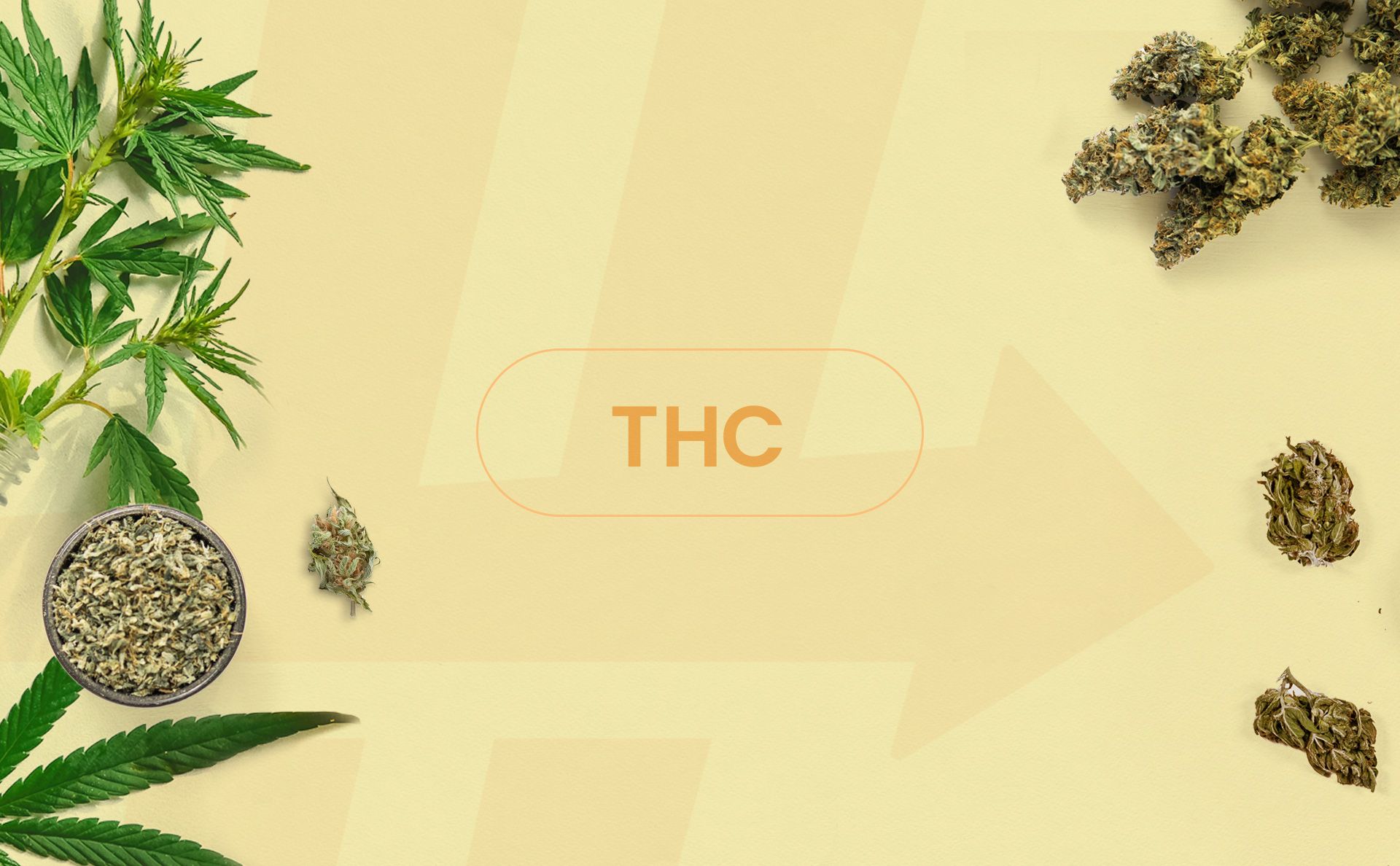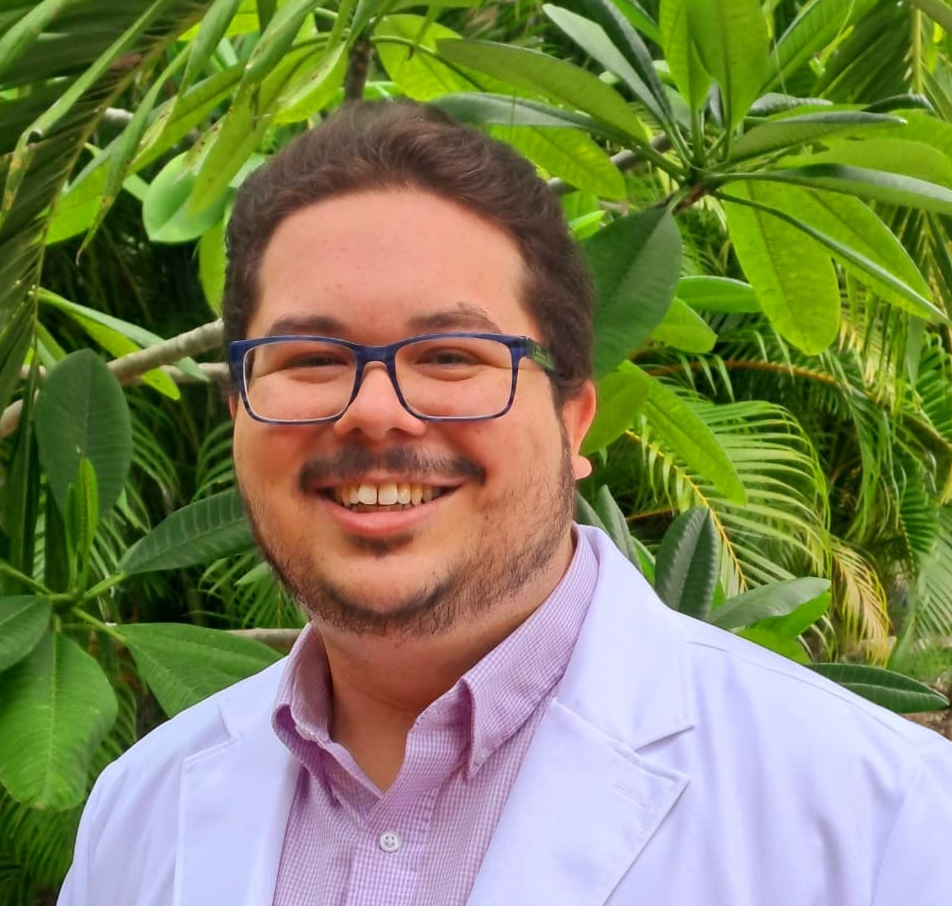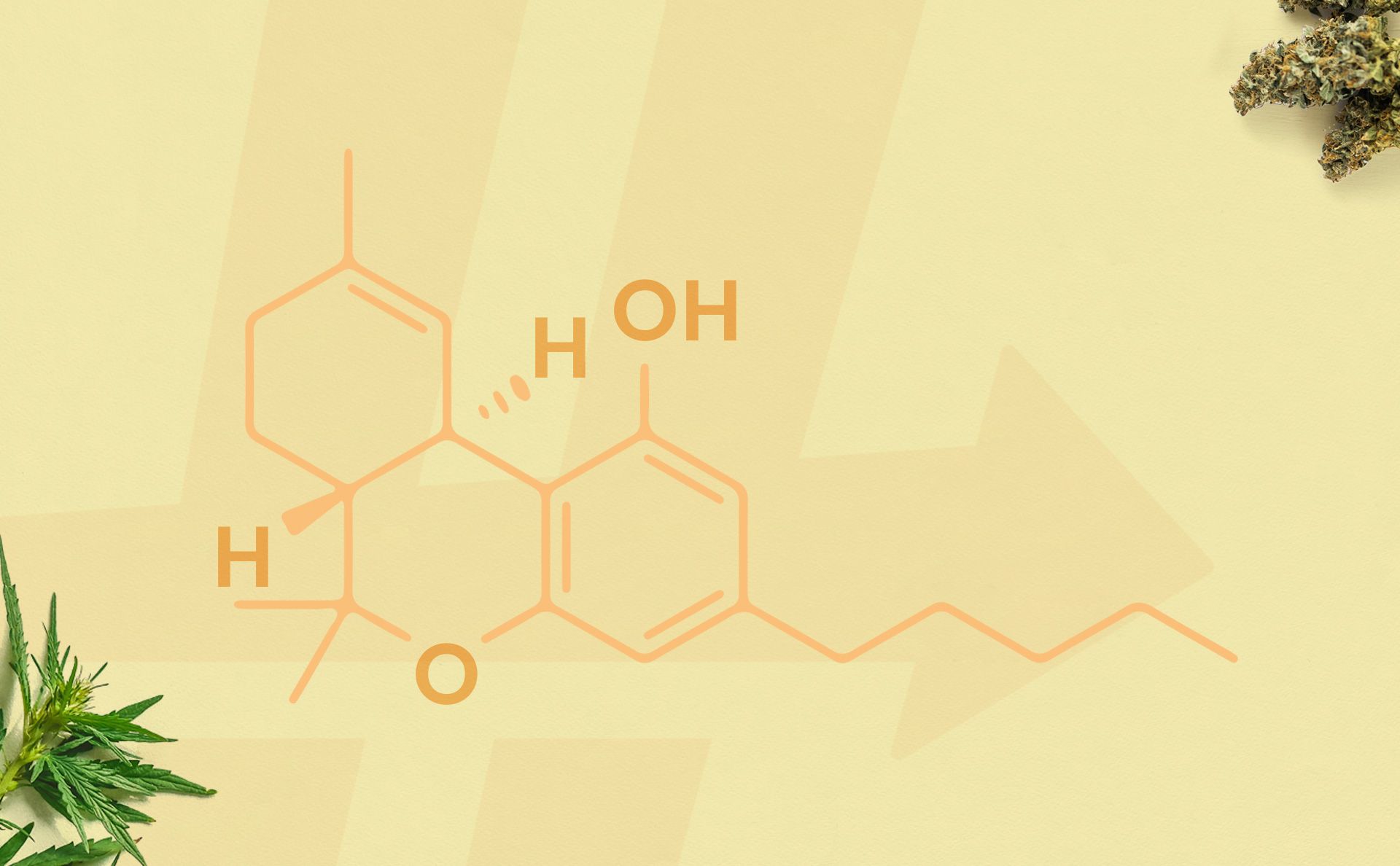What is THC?
Delta-9 tetrahydrocannabinol, or more commonly referred to as THC, is the best-known cannabinoid, and also the most misunderstood. What is this invaluable compound, its benefits, and its side effects? This chapter covers all of the above.

The main psychoactive ingredient in cannabis is called THC, or Delta-9-tetrahydrocannabinol. THC is also the second-most studied of all cannabinoids, only behind CBD. Here’s what we know about this important compound.
What Does THC Stand For?
Delta-9 tetrahydrocannabinol, or more commonly referred to as THC, is the main psychoactive compound in cannabis. When people say Cannabis, they most often think of THC first.
What is THC?
Delta-9 tetrahydrocannabinol, or more commonly referred to as THC, is one of the most abundant and active of all cannabinoids. THC is the most prevalent cannabinoid in what researchers call chemotype I cannabis, or THC-dominant cannabis in plain words.
THC directly stimulates our cannabinoid receptors to give therapeutic effects, cause a high, and improve mood. It also activates the reward system in the human brain by releasing the chemical dopamine. As a neurotransmitter, dopamine is tasked with our mood, appetite, pleasure, and so on.
After consuming THC, you may experience feelings of euphoria, due to the release of dopamine being higher than it normally is.
Arguably the most popular way of consuming THC is by smoking flower, although healthier consumption methods exist in legal markets. THC is also available in edible, concentrate, and topical forms. Be sure to check out the rest of our Guides and read up on all the different ways to consume THC.

What the expert says...
Dr. Abraham Benavides
"The best-known cannabinoid in the world, THC, is also responsible for the intoxicating effects felt by the consumer. Newcomers must take caution with dosing until they gain enough experience with THC."
Discovery of THC
THC was first discovered and isolated by the Bulgarian chemist Raphael Mechoulam, who was living in Israel in 1964. Mechoulam, who recently passed away, confirmed the existence of THC, but we still didn’t know how it worked.
At first, researchers thought THC disrupted cell membranes, but it took more than 20 years after its discovery for us to learn that THC is absorbed into the bloodstream upon consumption, and from there, travels to the brain. Once the compound arrives in the brain, it attaches itself to cannabinoid receptors.
THC and Cannabinoid Receptors
Cannabinoid receptors are found in the part of the brain known as the endocannabinoid system (ECS). This master feedback system is located in virtually every organ system to enable self-regulation and homeostasis. CB1 is abundant in the central nervous system, while CB2 regulates immune cells and supports nerve health throughout the body.
CB1 largely resides in key areas like the spinal column and brain areas like the cerebral cortex, cerebellum, hippocampus, amygdala, and basal ganglia. These are the parts of the brain responsible for thinking, memory, pleasure, coordination, movement, fear, and many other aspects of our lives.
Many people believe that since cannabis uniquely acts upon the naturally occurring system in our body known as the ECS, the plant plays a vital role in our overall well-being and perhaps evolution. For more information on the endocannabinoid system, be sure to check out our chapter “Cannabinoid Receptors”.
Effects of THC
Today, more than 230 million people worldwide use cannabis for a variety of reasons, including medicinal, recreational, and industrial. Chemotype I, or THC-dominant cannabis, is historically called “drug-type” cannabis because of its intoxicating recreational popularity, in addition to medicinal use for thousands of years.
However, “drug-type” is an archaic and stigmatizing term. And it’s a misnomer because many cannabinoids and plant-based compounds like terpenes act like non-psychotropic drugs, unlike THC and a few similar cannabinoids. The high of THC generally lasts around 3–10 hours, depending on the way it is consumed.
THC-dominant Cannabis
Researchers now broadly classify Cannabis by its main cannabinoids. THC-dominant cannabis is the kind most associated with psychotropic and euphoric effects. Cultivars that ultimately make high quantities of THC, CBD, CBG, or even none may be classified into distinct chemotypes:
- Type I – THC/A-dominant (most impairing)
- Type II – Balanced ~1:1 THC:CBD (less impairing but rarer)
- Type III – CBD/A-dominant (non-impairing, fiber-type hemp)
- Type IV – CBG/A-dominant (non-impairing, fiber-type hemp)
- Type V – No cannabinoids (industrial, fibrous)
CBD, CBG, and most of the minor (rare) cannabinoids are thought of as non-impairing, meaning they don’t get consumers high. Cultivars higher in non-impairing cannabinoids with little THC (less than 0.3% by dry weight) are considered fiber-type hemp.
THC is psychoactive and is the most abundant psychoactive cannabinoid that we currently know of. It’s far more common than other THC-like variants, such as delta 8 and THCP. This means that THC does in fact get you high, depending on the dose.
How Does THC Work?
THC makes consumers feel high by acting on a part of the brain known as cannabinoid receptor 1, or CB1. THC has five carbon atoms in an alkyl side chain that act upon these receptors. The more THC you consume, or the more carbons in the chain as with THCP, the more these molecules will interact with your CB1 receptors and the more intense the feeling.

THC also activates CB2 receptors, supplementing its anti-inflammatory and neuroprotective properties throughout the body.
Potential Benefits of THC
Many clinical and preclinical studies have been done on the effects of THC and its benefits since its discovery in 1964. Data eventually became convincing enough for pharmaceutical companies to make synthetic THC, which we will talk about more below.
Depending on the consumer, some research suggests that the potential therapeutic effects of THC and CBD may be greater when the cannabinoids are consumed in conjunction with whole-plant compounds. This phenomenon is known as the entourage effect. While some initial studies are promising, much more research is necessary to determine if this effect is evidence-based.
Chronic pain management is recognized as the most common indication for medical cannabis. Additionally, some potential benefits of THC include, but are not limited to, symptomatic relief in the following conditions:
- PTSD
- Chronic pain
- Insomnia
- Anxiety and Depression
- Nausea
- Cancer- and treatment-related symptoms
- Glaucoma
- Epilepsy and seizures
- Cachexia and wasting syndrome
- AIDS
- Multiple sclerosis with muscle spasticity
- Fibromyalgia
- Alzheimer's disease
- Amyotrophic lateral sclerosis
- Hepatitis C infection
- Chronic Migraines
- Arthritis
- Inflammation
- Crohn's disease
These are just a few examples of the vast potential benefits of cannabis for which we have empirical evidence. There are thousands, perhaps millions, of accounts of anecdotal evidence that indicate many other healing properties of cannabis medicine.
Pharmaceutical THC
Whole-plant cannabis medicine has not yet been approved by the U.S. Food and Drug Administration (FDA) to treat any condition, for a myriad of reasons we won’t get into here.
However, there are a few notable, synthetic THC drugs that the federal agency has approved: dronabinol and nabilone.
- Dronabinol (e.g., Marinol®, Syndros®) are FDA-approved drugs that contains dronabinol, which is synthetic THC. These drugs are prescribed to cancer patients undergoing chemotherapy and to treat their refractory nausea and vomiting. This drug is also prescribed to HIV/AIDS patients to help treat weight and appetite loss.
- The active ingredient in the brand-name drug Cesamet® is nabilone, a synthetic cannabinoid similar to THC. It is also given to cancer patients for nausea and vomiting when other drugs haven't worked.
- Unfortunately, nabiximols (pharmaceutical 1:1 THC:CBD) is approved in almost 30 other countries outside the US for the treatment of pain and muscle spasms in multiple sclerosis.
While it is encouraging that the FDA has acknowledged and approved cannabinoid-based drugs for safe and effective use, much more work must be done if we are to ever realize the full therapeutic potential of cannabis medicine.
Possible Side Effects of THC
Some consider the feeling of being high to be one of the side effects of THC. This is important to note before we discuss the possible bad side effects. Similarly, increased appetite and sleepiness may not be desirable for all – but could be of desperate relief for some.
These possible adverse side effects of the world’s most crucial cannabinoid commonly include:
- Euphoria or dysphoria
- Impairment and intoxication
- Paranoia
- Anxiety or panic
- Sleepiness
- Fatigue
- Dizziness
- Lethargy
- Dry mouth
- Dry, red eyes
- Temporary memory lapse
- Increased heart rate
- Decreased motor coordination
- Increased appetite in smaller doses
Less commonly:
- Upset stomach in larger doses
- Nausea and vomiting in excessive doses
- Chronic bronchitis from cannabis smoking
- Cardiopulmonary risks from cannabis smoking
- Negative fetal growth and developmental effects in pregnancy and children
For the majority of consumers, these potential bad side effects are typically only felt after ingesting a dose of THC that is too intense for them. CBD can help counter the intense effects, like anxiety, from too much THC.
High-dose THC and Repeat Use Side Effects
The intensity of THC side effects largely depends on the dose, route, frequency, and metabolism of the consumer. THC-rich concentrates and edibles are more likely to cause side effects because they have very large amounts of THC, and edibles have longer and stronger THC activation features.
People who use cannabis multiple times daily or concentrated THC products will experience tolerance to its effects building up rapidly. High-THC or repeat cannabis use can also lead to dependence in a small set (~10%) of people. Cannabis withdrawal is also possible due to THC’s intoxicating effects, but is nonfatal.
In 2004, a new condition called cannabinoid hyperemesis syndrome emerged. CHS is documented in people coming to the ER with cyclical vomiting after heavy THC use, characterized by hot shower relief of vomiting.
The psychiatric risks of high-THC are debated, and seem to be more relevant for people with genetic or family history susceptibility for severe mental illness. Caution must be exercised in these individuals.
Can you overdose on THC?
Thankfully, there has never been a recorded death attributed to cannabis consumption alone.
This is largely thanks to the fact that even though cannabinoid receptors are widespread in the brain, they aren't in our respiratory centers. This means cannabis doesn't stop you from breathing like an opioid overdose does
Still, it’s essential to consume cannabis slowly and work your way up to understanding your proper dosage. Doing so can help you avoid the potential negative side effects.
What We Learned: What is THC?
As we’ve mentioned before, we are just scratching the surface of the wonderful world of cannabinoid research. Much is left to be explored, researched, experienced, and understood about the invaluable compound THC. Here’s what we learned about THC in this chapter:
- Delta-9 Tetrahydrocannabinol, or more commonly referred to as THC, is the main psychoactive ingredient in cannabis.
- THC activates the endocannabinoid and reward system in the brain by releasing the chemical dopamine.
- THC was first discovered and isolated by the Bulgarian chemist Raphael Mechoulam, who was living in Israel in 1964.
- THC has five carbon atoms in an alkyl side chain that act upon CB1 and CB2 receptors. The more THC you consume, the more these molecules will interact with your CB1 receptors and the more intense the feeling.
- There is no practically lethal dose of THC or cannabis known yet. However, conditions like CHS and CUD are serious considerations.
- THC may help alleviate patients’ suffering from cancer, Crohn's disease, glaucoma, multiple sclerosis, arthritis, and many more.
- Common side effects of THC include paranoia, sleepiness, anxiety, increased appetite, dry mouth, and red eyes.
As legalization efforts continue, we will see more much-needed unbiased research become easier to conduct and information will become more readily available. As this research continues, we will almost certainly discover and better understand more of the therapeutic benefits of the consumption of THC.
Citations
- Chayasirisobhon, S. (2020). Mechanisms of Action and Pharmacokinetics of Cannabis. The Permanente Journal, 25, 19.200.https://doi.org/10.7812/TPP/19.200
- Chu, F., & Cascella, M. (2024). Cannabinoid Hyperemesis Syndrome. In StatPearls. StatPearls Publishing.http://www.ncbi.nlm.nih.gov/books/NBK549915/
- Connor, J. P., Stjepanović, D., Le Foll, B., Hoch, E., Budney, A. J., & Hall, W. D. (2021). Cannabis use and cannabis use Disorder. Nature Reviews. Disease Primers, 7(1), 16.https://doi.org/10.1038/s41572-021-00247-4
- Crocq, M.-A. (2020). History of cannabis and the endocannabinoid system. Dialogues in Clinical Neuroscience, 22(3), 223–228.https://doi.org/10.31887/DCNS.2020.22.3/mcrocq
- Ebbert, J. O., Scharf, E. L., & Hurt, R. T. (2018). Medical Cannabis. Mayo Clinic Proceedings, 93(12), 1842–1847.https://doi.org/10.1016/j.mayocp.2018.09.005
- Mansell, H., Quinn, D., Kelly, L. E., & Alcorn, J. (2022). Cannabis for the Treatment of Attention Deficit Hyperactivity Disorder: A Report of 3 Cases. Medical Cannabis and Cannabinoids, 5(1), 1–6.https://doi.org/10.1159/000521370
- Marijuana and Cancer | Cannabinoid Drugs. (2022, August 3).https://www.cancer.org/cancer/managing-cancer/treatment-types/complementary-and-integrative-medicine/marijuana-and-cancer.html
- McCartney, D., Suraev, A., & McGregor, I. S. (2023). The “Next Day” Effects of Cannabis Use: A Systematic Review. Cannabis and Cannabinoid Research.https://doi.org/10.1089/can.2022.0185
- Russo, E. B. (2011). Taming THC: Potential cannabis synergy and phytocannabinoid-terpenoid entourage effects. British Journal of Pharmacology, 163(7), 1344–1364.https://doi.org/10.1111/j.1476-5381.2011.01238.x
- Schlienz, N. J., Spindle, T. R., Cone, E. J., Herrmann, E. S., Bigelow, G. E., Mitchell, J. M., Flegel, R., LoDico, C., & Vandrey, R. (2020). Pharmacodynamic dose effects of oral cannabis ingestion in healthy adults who infrequently use cannabis. Drug andhttps://doi.org/10.1016/j.drugalcdep.2020.107969
- Shahbazi, F., Grandi, V., Banerjee, A., & Trant, J. F. (2020). Cannabinoids and Cannabinoid Receptors: The Story so Far. iScience, 23(7), 101301.https://doi.org/10.1016/j.isci.2020.101301
- Siracusa, L., Ruberto, G., & Cristino, L. (2023). Recent Research on Cannabis sativa L.: Phytochemistry, New Matrices, Cultivation Techniques, and Recent Updates on Its Brain-Related Effects (2018–2023). Molecules, 28(8), 3387.https://doi.org/10.3390/molecules28083387
- Walsh, K. B., McKinney, A. E., & Holmes, A. E. (2021a). Minor Cannabinoids: Biosynthesis, Molecular Pharmacology and Potential Therapeutic Uses. Frontiers in Pharmacology, 12, 777804.https://doi.org/10.3389/fphar.2021.777804
- Walsh, K. B., McKinney, A. E., & Holmes, A. E. (2021b). Minor Cannabinoids: Biosynthesis, Molecular Pharmacology and Potential Therapeutic Uses. Frontiers in Pharmacology, 12.https://www.frontiersin.org/articles/10.3389/fphar.2021.777804
Test your knowledge, track your progress and earn your badge.
When was THC was first discovered and isolated?

Dr. Abraham Benavides
Dr. Abraham Benavides is an internationally-recognized cannabis research expert, experienced medical advisor, and full-tuition merit scholar of the George Washington University School of Medicine and Health Sciences. Dr. Abe enjoys helping patients as a writer, educator, and cannabis health coach at the GW Center for Integrative Medicine.